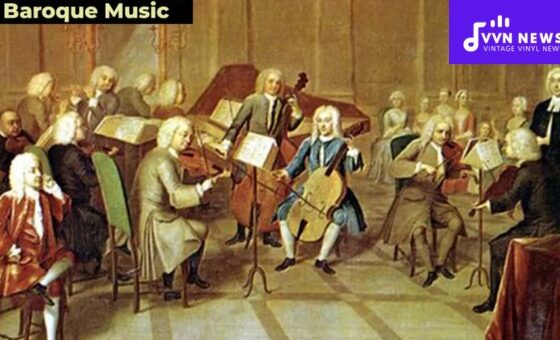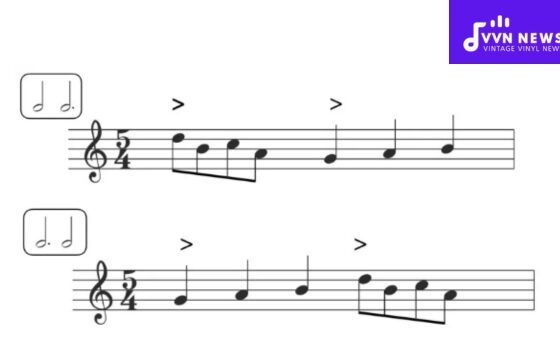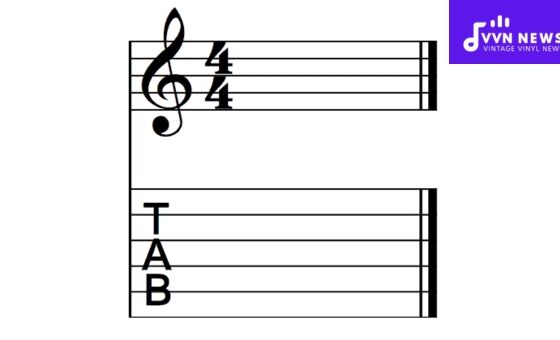Music, rhythm, and timing set the scene. They’re much like the heartbeat of a composition, giving the melody a unique flavor or mood.
One of the most engaging and dynamic expressions of this rhythmic heartbeat is seen in the time signature 3/4. Grooving to a tune with a time signature of 3/4 is an experience in itself.
This signature has a charm that resonates with listeners and musicians alike, creating an atmosphere that’s both exciting and calming in its own right.
From Hungarian waltzes to contemporary pop ballads, this time signature has been embraced by genres across the board, giving it an evergreen relevance in the world of music.
What Is the Time Signature 3/4?
The 3/4 time signature is one of the many ways that musicians keep track of rhythm and time in a piece of music. It’s characterized by three beats per measure (bar), with a quarter note receiving one beat.
This numeral fraction translated to words implies ‘three quarter-notes’. Waltz is the perfect example embodying this signature, where you count “one-two-three, one-two-three”.
In essence, a piece written in 3/4 time will have this timing structure repeated throughout.
It leaves a musical trail–a unique footprint that follows the rhythmical patterning ‘strong-weak-weak’. No matter how it may vary slightly in flavor or phrasing, its essence remains unchanged – every measure contains unmistakably, three pulses!
Also Read: Phrygian Mode [Adding Exotic Flair To Your Musical Compositions]
How Do You Count in 3/4 Time?
The numbers in a time signature such as 3/4 indicate the rhythm of the song.

Specifically, the top number ‘3’ tells you how many beats are in each measure, while the bottom number ‘4’ tells you the type of beat—in this case, a quarter note.
To count in 3/4 time effectively, envision each measure being divided into three beats. You’ll count “1-2-3,” “1-2-3,” with emphasis placed on every first beat to facilitate this rhythm.
This rhythmic flow represents a cycle that typically repeats throughout the piece, which creates a unique atmosphere linked with 3/4 time.
This is frequently used to generate waltz-like movements that provide an elegant and uplifting pulse to tracks crafted in this signature.
Why Is 3/4 Considered a Simple, Triple-Time Signature?
At its core, the 3/4 time signature exemplifies both simplicity and triplicity, giving it an almost intrinsic waltz-like quality. Each bar is segmented into three beats, with each beat comprising a single quarter note.
The beauty lies in how these beats gracefully distribute across the measure, creating a rhythmic pattern where the first beat typically receives the primary accent, instilling a sense of natural flow.
The terminology ‘simple’ refers to the division of each beat into two equal parts.
In other words, you can split each quarter note further into two eighth notes, thus retaining the simplicity of its breakdown. This contrasts with ‘compound’ time signatures where beats divide into three smaller parts.
When we say a time signature is ‘triple,’ we pinpoint its structure of having three beats per measure. This triad of beats gives breathing space for dancers and musicians to feel the pulse intuitively.
Conclusively, 3/4’s simplicity offers ease for composers and listeners to engage rhythmically, making it an enduring staple in music’s rhythmic repertoire.
Also Read: A Sharp Minor Pentatonic Scale [Unique Harmonic Possibilities]
Famous Songs in 3/4 Time Signature
The 3/4 time signature, often associated with the classic waltz rhythm, leaves a distinct and unforgettable impression within the tapestry of music history.
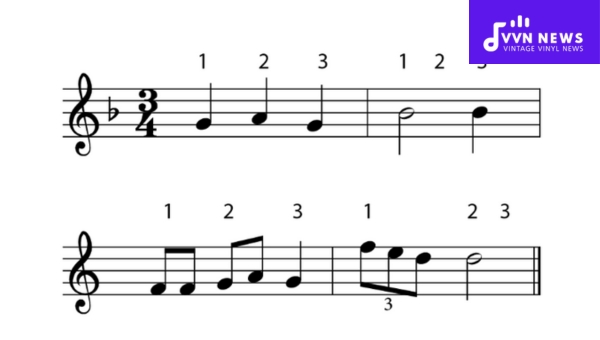
Its distinctive one-two-three pulse has lent itself to many memorable songs across various genres. Here are a few iconic tunes written in this timeless meter:
- “Manic Depression” by Jimi Hendrix: This rock classic showcases Hendrix’s creative agility to infuse the waltz rhythm into a psychedelic blues context.
- “Blue Danube” by Johann Strauss II: No list is complete without this opulent, flowing waltz; it epitomizes the elegance and grace of 3/4 meter.
- “The Tennessee Waltz” by Patti Page: Blending country roots with mainstream appeal, this song demonstrates how seamlessly 3/4 can glide through different styles.
- Leonard Cohen’s “Hallelujah” employs the waltz time to give a spellbinding cadence that supports its poignant lyrics.
Each piece distinctly weaves 3/4 time into its melodic and harmonic fabric, showcasing just how versatile and emotionally compelling this rhythm can be.
It’s eliciting an urge to twirl in a ballroom or giving depth to poetic lyrics, the presence of this triplet-centric beat creates compelling sonic landscapes recognized worldwide.
How Does 3/4 Time Differ from 4/4 Time?
The distinction between 3/4 and 4/4 time signatures is central to grasping the pulse of various musical pieces.
In essence, a 3/4 time signature means each measure contains three beats, with a quarter note equating to one beat.
Visually, imagine a waltz where dancers gracefully glide in a ONE-two-three pattern, emphasizing the first step.
Contrastingly, 4/4, known as “common time,” accommodates four beats per measure, maintaining the quarter note’s value as one beat.
The pulse here is more robust and straightforward, think of drumming your fingers on a table to a rock song in an instinctive ONE-two-three-four sequence.
These patterns and characteristics will help you distinguish between these two predominant rhythmic structures in music.
Also Read: How To Transpose Bass Clef To Treble Clef [A How-To Guide]
What Makes 3/4 and 6/8 Time Signatures Different?
When you delve into the rhythmic landscapes of music, you’re likely to encounter the distinctive time signatures of 3/4 and 6/8.
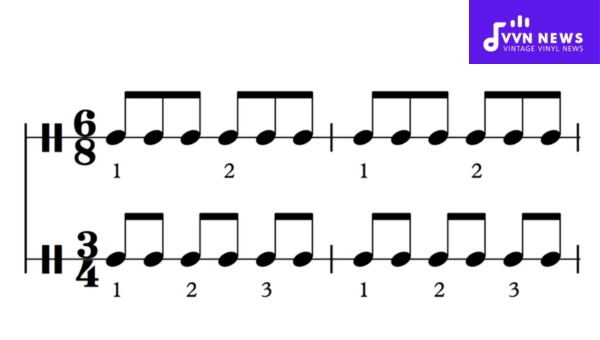
While they could ostensibly share a commonality in the total count of beats—six in both—a closer look reveals their unique characteristics.
Pulse Groupings and Accents
The fundamental difference lies in how we group beats and where we place the emphasis.
- 3/4: This signature, often associated with waltzes, divides its six beats into two groups of three. Each measure contains three quarter-note beats, with stress traditionally placed on the first beat: 1-2-3.
- 6/8: This time signature groups its beats in a contrasting way—two groups of three eighth notes. Here, we have six eighth-note beats per measure, with a conventional accent on the first beat: 1-2-3 4-5-6. The ‘4’ is typically less strong than the ‘1’, creating an inherent “rolling” feel.
Tempo Interpretation
The subdivision of beats gives each time signature an unmistakable tempo:
- In 3/4, the quarter note pulse makes it easy for musicians to convey songs at various speeds by adjusting this singular beat’s tempo.
- With 6/8, given that it operates primarily with eighth notes, this results in a quicker pace that’s ideal for dances like tarantellas or jigs.
Distinguishing these two-time signatures is essential not only for reading music but also for appreciating the distinct moods they craft within compositions.
A simple mnemonic to remember: think of 3/4 as walking; steady and upright, while 6/8 flows like running; agile and buoyant.
How Can You Identify a Piece Written in 3/4 Time?
Identifying a piece in 3/4 time involves listening closely to the rhythm. Each measure will consist of three beats, with the first beat usually emphasized.
Imagine a waltz – where dancers count ‘one-two-three, one-two-three.’ To spot this time signature, follow these tips:
- Look for the time signature on sheet music at the beginning of a staff, after the clef symbol – it’s denoted as ‘3/4.’
- Listen for songs where beats seem grouped into threes; they often sway or induce a feeling of being rocked gently.
- Clap along to the melody, and if you naturally feel breaks after every third clap, there’s a high chance it’s in 3/4.
Discovering music written in 3/4 time can be satisfying and adds an extra layer to your appreciation of rhythmic patterns.
With these pointers, you’ll quickly start picking out those triple-meter tunes!
FAQs
What distinguishes 3/4 time from other time signatures?
3/4 time is characterized by three quarter-note beats per measure, creating a waltz-like rhythm that’s often described as having a sway.
How can I quickly identify a song in 3/4?
You’ll notice the music has a consistent “ONE two three, ONE two three” pulse. Each measure will feel like it has three distinct beats, with the first beat typically being the strongest.
Are there genres more prone to use 3/4 time?
Yes, waltzes and ballads frequently utilize 3/4 time to achieve their distinctive flowing motion. Various genres have pieces in this time signature.
What’s an easy way to practice counting in 3/4?
Tap your foot three times for each measure with an emphasis on the first tap and repeat “ONE two three” in sync with your taps.
Can you list a few well-known tracks composed in 3/4?
Absolutely! Some iconic tracks include “The Tennessee Waltz,” “Blue Danube Waltz,” and Leonard Cohen’s “Hallelujah.”
Also Read: How To Transpose Treble To Bass Clef [Music Guide]
Conclusion
The 3/4 time signature is a fascinating aspect of music that adds a unique rhythmic dimension to compositions. Its distinctive waltz-like cadence invites you into a world where groups of three beats dance in harmony.
You’ll find it in genres ranging from classical to folk, and even rock. To fully appreciate the beauty of this time measure, immerse yourself by listening to iconic 3/4 tracks and perhaps even tapping along to the beat.
Whether you’re a music enthusiast or an aspiring musician, exploring 3/4 time will undoubtedly enrich your musical experience.


